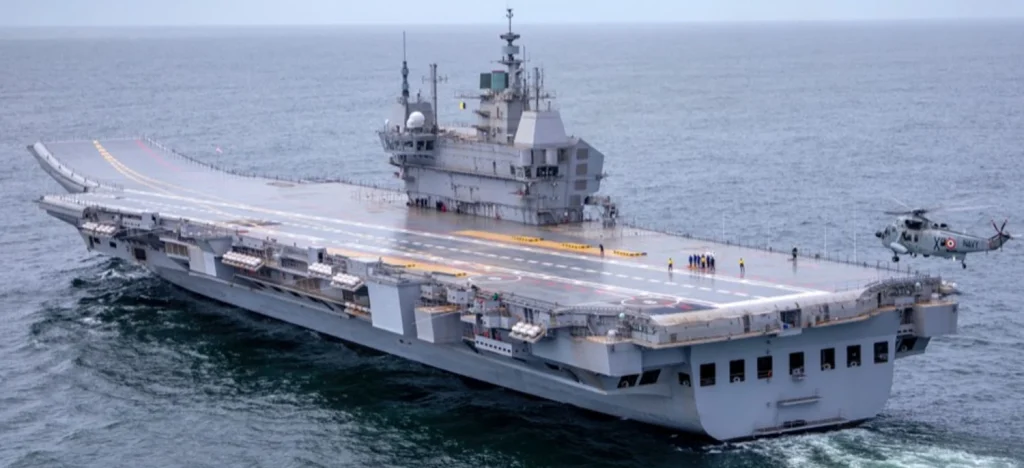India wishes to establish itself as the dominant force in the Indian Ocean. The Indian leadership considers the region from Africa’s east coast to Southeast Asia its sole domain. A battle is brewing between India and China over where the future line of demarcation between their respective spheres of influence will be drawn. To do so, India needs a strong ocean fleet, which would be impossible to achieve without an aircraft carrier fleet.
The request for information (RFI) was officially published in January 2017, kicking off a major competition for the supply of future carrier-based fighters for the Indian Navy. It confirmed India’s plans to build more aircraft carriers and strengthen the armed forces qualitatively, and it became an event in the global military aviation market.
Why does India need new fighters?
The new programme calls for the acquisition of 26 (scaled down from 57) “multi-role carrier-based fighters” (Multi-Role Carrier Borne Fighters – MRCBF, as the competition is now known) for future Indian aircraft carriers. Following the retirement of the INS Viraat aircraft carrier, which carried Sea Harrier VTOL aircraft, Indian carrier aviation is now flying Russian MiG-29K and MiG-29KUB fighters (single and double seater variants, respectively) from INS Vikramaditya, the former Admiral Gorshkov, a Soviet-built cruiser that was radically modernized (actually rebuilt) in Russia at the end of the 2000s and became part of the Indian fleet.

The most recent aircraft carrier, Vikrant, is set to be commissioned in 2022. There is also the possibility of constructing a larger tonnage carrier presumably called ‘Vishal’ or IAC 2 (Indian Aircraft carrier 2) or INS Vishal in the future. The Indian Navy wants it to have catapults for launching aircraft, and it plans to collaborate with the Americans to install an ultra-modern electromagnetic aircraft launch system (EMALS). Vishal is unlikely to arrive before the middle of the next decade, but the air group is worth considering now.
The planes will not be ready immediately after the order is placed. Of course, the RFI formally specifies strict deadlines – to begin aircraft deliveries within three years of contract signing and to deliver 57 (during the tender release) aircraft over the next three years, implying high development rates for aircraft modifications created specifically for MRCBF and production rates. These terms will most likely be ignored in the future.
There is also a chance that the Navy will need to buy the aircraft right away because the era of fourth-generation fighters is coming to an end. Production of Both the American F/A-18E/F Super Hornet deck carrier and the French Rafale M could be phased out this decade.
The way forward
The American F/A-18E/F Super Hornet deck carrier and the French Rafale M have already been tested and await the Indian Navy’s decision.
The Indian Navy faces a difficult decision because the chosen aircraft can be used for both the Vikrant and Vishal carriers. Fitting Hornets and Rafales into Vikrant may be difficult because it was designed to operate Mig-29Ks.
Mastering the aircraft will take a long time, including ground training on aircraft carrier simulators simulating take-offs from ground-based catapults and landings on arresters. The Vishal-borne fighters would be ideal if they could also be operated on existing aircraft carriers. Judging by the RFI, the Indian Navy would be delighted to receive an aircraft capable of taking off from both a ski jump and a catapult. The Chinese, too, have a similar challenge, and it is not known if they will have different or the same aircraft for the two types of carriers. They are known to have tested the prototypes of a new modification of their Su-33, aka J-15, on ground-based catapults.

The American F/A-18E/F Super Hornet and the French Rafale M are both likely candidates for “Vishal” to be equipped with. The aircraft carrier itself could be built in collaboration with American or French shipbuilders and engineers.
The Super Hornet is an interesting option, as it is cheaper than a French fighter, and Boeing will clearly be able to produce them at a faster rate than the French Dassault. Besides, even the French have ordered EMALS for their new carrier from the Americans.
And what about Russia’s chances? Indeed, at first glance, it would be quite reasonable for the Indian Navy to continue purchasing MiG-29K/KUB. The Russian side would offer a clearly updated set of electronic equipment, localization of production and transfer of technologies so dear to the Indians. Probably the aircraft would even be called the MiG-35K/KUB (which would be funny since the MiG-35 itself is a modernized land-based version of the MiG-29K/KUB). However, it is not known if the Russians can create a catapult version and help the Indian Navy with creating a catapult-based carrier. This was not a fundamentally unsolvable task if the Soviet nuclear aircraft carrier Ulyanovsk had time to enter service. Then the Su-33s would take off both from Ski Jumps and from catapults.
